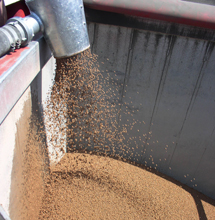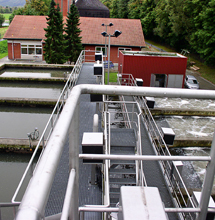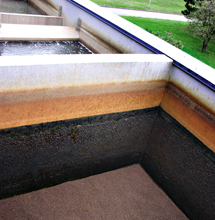Liaperl
Colony for microorganisms
The preservation of natural resources includes the careful use of drinking water. To ensure ever safer drinking water quality combined with a reliable supply, it is necessary to reduce the pollutant load in waste water. Mechanical plants using conventional purification technology employ only the physical sedimentation process in which the solid and liquid phases of the waste water are separated. By contrast, biological treatment plants use microorganisms to clean the waste water. The Liapor product Liaperl makes the ideal substrate for colonization by this miniature life form. Liaperl is a spherical expanded clay whose properties can be adapted precisely for each individual filtration plant. Due to the Liapor manufacturing process, it is possible to obtain grain layers of differing granularity and consequently different filter materials. In this way, it is possible to vary the surface structure that forms the substrate on which the microorganisms are able to act. However, it is also possible to modify the rigidity of the material, which results from the volume and distribution of the pores.
For the biofiltration of waste water
The biofiltration of waste water, in which aerated filters are filled with coarse Liaperl, is based on a wealth of experience stretching back to the 1980s. In most cases, Liaperl expanded clay spheres spheres with specifically determined surface areas of 800 to 900 m2/m3 for 4-8 mm are chosen. As a result, high biomass concentrations can be achieved even in only small tank sizes, thus saving both space and costs. Larger grain sizes can also be used. However, although these have larger surface areas, they increase the risk of filter blockages. Liaperl is generally used in the biological stage in large-scale purification plants in order to reduce the nitrogen and phosphate content of the waste water. However, Liaperl is also suitable for use in small purification plants and constructed wetland.
Wide range of specific filter materials
In fixed-bed reactors, Liaperl is used as a colonization substrate for microorganisms. The desired properties can be precisely adapted using the defined Liaperl granularity bands: This applies both to the special surface, the so-called reaction surface, and to the hydraulic properties of the fixed bed that result from the volume and distribution of the pores. Liapor's manufacturing process makes it possible to create a wide range of specific filter materials. The standard granularity bands employed are 3/6 mm, 4/8 mm and 8/16 mm. However, the granularities can also be precisely adapted to the customer's requirement – in the same way as the bulk density ranges of the Liaperl granules, which lie between 0.4 kg/dm3 for floating coverage and up to 1.8 kg/dm3 for biological waste water treatment in large- and small-scale purification plants and in constructed wetland projects and trickling filter plants.
Durable with good flow-promotion properties
The rough microscopic shell of the Liaperl material has a high-relief surface that provides a permanent home for microorganisms. After the regularly required rinsing of the filter, the fixed bed is soon ready for action again because the biological flora recovers quickly. A further advantage: Due to its spherical shape, Liaperl promotes the flow of liquid and the closed pores save a lot of energy during backflushing when compared to other filter materials. Thanks to its mechanical strength, Liaperl is extremely durable. At the end of its active life, Liaperl can simply be disposed of in building waste landfill sites or in agricultural sites, provided that the treated waste water contains no problematic substances.


